by Jim Baumann

1/350 UB-1 (U-boat Laboratorium)

At the outbreak of WW1 nobody could foresee what a pivotal role the submarines would play in this war. The breakthrough of the German army to the English Channel coast took the Imperial Navy staff by surprise - the war was assumed to be of short duration... The Belgian ports in Flanders had been captured undamaged, and the need for a compact submarine to operate from these bases soon became apparent.
The initially fast-moving war ended in a virtual stalemate; the opposing sides dug into trenches and the German High command began to seek alternative methods to hasten the route to ultimate victory.
Germany quickly realized the strategic value of Ostend and Zeebrugge in the war of attrition; being only 75 miles away from Dover and 12 hours from the Home- submarine bases at Helgoland.
On 9 November the German submarine U12 arrived at Zeebrugge and was the fisrt to commence operations. Almost immediately it became apparent that the existing submarines were too large to operate in the shallow shoal waters of the English Channel and Southern areas of the North Sea.
The requirements were for a small coastal submarine of simple construction, which could be transported by railway in disassembled state.
Of various submitted designs, type UB l was chosen. She was 92 ft ( 28 metres) long, displacing 125 tons and powered by a 60 hp Diesel engine and 120 hp Electric motor.
Two bow 450-mm torpedo tubes and one 7.92 mm machine gun gave her offensive capability
UB-1 to UB-8 were ordered from Germaniawerft and UB·9 to UB-15 from AG Weser. Subsequently both UB-1 and UB-15 were given to the Kuk Austro-Hungarian navy.
Trials showed these boats were rather slow - surface speed was only 6 knots and 5.5 knots submerged; -- capable however of diving in 22 seconds!!
The submarines were transported to their bases in five separate sections by rail. Upon arrival at Antwerp assembly was completed within 2 weeks.
Despite their hurried design and build, in service they were successful. The main disadvantage being their diminutive size; the firing of a torpedo made the bow rise- and thereby visible to the enemy. The crew running forward to the torpedo room to compensate for the weight/balance shift negated this problem!
The boats operated in the North Sea, Baltic, Black Sea and the Mediterranean. UB-6 was the most successful; completing 60 combat cruises and sinking 15 enemy vessels as well as RN destroyer HMS Recruit.
The type numbered 20 built, and despite their diminutive size they accommodated 14 officers and men on sorties of up to 6 days
My model was built using the small resin kit by U-boat Laboratorium consisting of the hull, a resin stand and two PE frets.
A truly esoteric subject, the kit is neatly packaged with detailed historical detail notes and with the comprehensive instructions; the model was simple to build.
I merely omitted the PE rigging and rails; preferring to replace these with stretched sprue.
The later boats carried some pretty outlandish colour and ‘disguise’ schemes; UB-1 however was deemed to have been painted in ‘mid’grey- so I used Humbrol 64 !
The display pedestals are brass cup bearings used in Model Railways and the submarine is mounted on a small square of black Perspex.
I added a figure to the display to permit the unfamiliar observer to appreciate just how cramped the conditions aboard must have been!!
My kit came direct from U-boat Laboratorium in Russia
